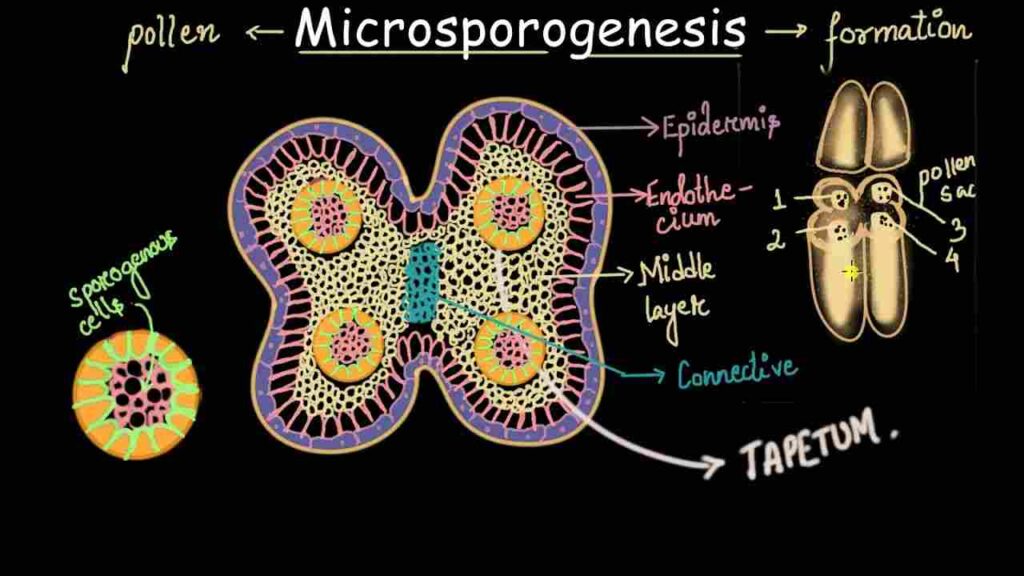
Explore 15 Key Difference between Microsporogenesis and Megasporogenesis
Microsporogenesis and megasporogenesis are two processes that occur in the reproductive structures of plants, leading to the formation of male and female gametes respectively. While both processes involve the production of gametes, there are several differences between microsporogenesis and megasporogenesis. Let’s explore 15 key difference between Microsporogenesis and Megasporogenesis in simple terms that will help you to understand in simpler way for your upcoming exams.
Difference between Microsporogenesis and Megasporogenesis
Location: Microsporogenesis takes place in the pollen sacs of the flower’s anther, while megasporogenesis occurs in the ovule, which is located inside the ovary.
Gamete production: Microsporogenesis creates microspores, which mature into pollen grains or male gametophytes. Megaspores are created during megasporogenesis, and they grow into female gametophytes.
Two divisions occur in sequence during microsporogenesis, producing four microspores as a result. Eight nuclei are formed within the growing megaspore as a result of three successive divisions during the megasporogenesis process.
Cytoplasm division: In the course of microsporogenesis, the cytoplasm divides after each division, resulting in the formation of four distinct microspores. Megasporogenesis produces a single megaspore because cytokinesis doesn’t start until after the last division.
Ploidy level: Haploid microspores are produced by microsporogenesis, while haploid megaspores are produced by megasporogenesis.
Condition of the nucleus: The microspores’ nuclei undergo mitosis during the process of sporogenesis, resulting in nuclei that are genetically identical. Meiosis, a reduction division that occurs during megasporogenesis of the nucleus, produces genetically diverse nuclei within the megaspores.
Microspores typically have a smaller cell size than megaspores.
Support for nutrition: Microspores are self-sufficient and do not need outside assistance for nutrition. On the other hand, megaspores are typically surrounded by nutritive tissue within the ovule, which supplies nutrition for their growth.
Non-functional microspores in the microsporogenesis process degenerate and are not used in subsequent development. Megasporogenesis results in the degeneration of non-functional megaspores, allowing for the development of a single functional megaspore.
Male/female gamete formation: Within the pollen grains, microsporogenesis causes the development of male gametes (sperm cells). The female gametophyte develops female gametes (egg cells) as a result of megasporogenesis.
Pollination: During pollination, microspores are propelled from the anther to the stigma. The ovule, which is typically fertilised by pollen grains for advancement, is where megasporogenesis takes place.
Genetic diversity: Because meiosis is absent during microsporogenesis, there is little genetic diversity. The meiotic division that occurs during megasporogenesis adds to the genetic diversity of the resulting gametes.
Timing: During a plant’s reproductive cycle, microsporogenesis typically takes place before megasporogenesis.
Overall purpose: The production of male gametes for fertilisation is the main goal of microsporogenesis. The formation of female gametes and the subsequent formation of seeds after fertilisation are the main goals of megasporogenesis.
All flowering plants’ anthers undergo microsporogenesis, whereas only gymnosperms and angiosperms undergo megasporogenesis.
Location, gamete production, number of divisions, ploidy level, nucleus condition, cell size, nutritional support, fate of non-functional spores, male/female gamete formation, pollination, genetic variation, timing, overall function, and occurrence are difference between microsporogenesis and megasporogenesis. The diversity and procreation of plants in various ecosystems are influenced by these variations.
Also Read: Explore 15 Difference between Adolescence and Puberty